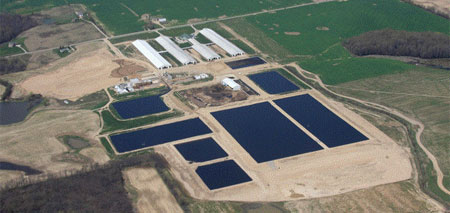Well, the days are getting longer, the to-do list is getting longer, and the blog posts are getting shorter. There’s plenty going on to write about, but precious little time to do the actual writing.
Anyhow, I wanted to pass along two stories for anyone (myself included) who wonders how a small pork producer can make it in the hyper-globalized industrial pork world we live in.
The first, from Business Week, tells of the financial impacts that ractopamine is having on the US pork industry. If you’ve never heard of ractopamine, your not alone. It’s a chemical that some producers (don’t worry, not us!) put in their pig’s feed to promote growth and leanness.
Ractopamine has been deemed safe by US authorities, but is banned by the EU, Russia and China. That’s right, China, the people who have the big “Pigfestation” problem at least have the good sense to say “No Thanks” to chemical additives in their pig feed.
Now in addition to being kind of gross, the use of this chemical is also quite unfair to small producers. The smaller pork producers have a choice. Either they use Ractopamine (sold as Paylean) to become cost-competitive with the big guys but lose the ability to sell overseas, or don’t use Paylean, but be at a $5 pricing disadvantage. (If you’re unfamiliar with industrial-scale farming, $5 is a HUGE deal, as big and little guys alike operate on margins measured in pennies.)
To make matters worse, the small pork producers all end up selling to the very meatpackers that are owned by the big pork producers. This “vertical integration” (read: monopoly) has existed for decades in the chicken industry, and has spread to the pork industry as well.
Which brings me to the second story, wherein the 800lb Gorilla of the US pork industry, Smithfield foods, has taken their vertically-integrated business model overseas, with predictable results.
Robert Wallace, a visiting professor of geography at the University of Minnesota says Smithfield’s global rise is part of a broader “livestock revolution that has created cities of pigs and chickens” in poorer nations with weaker regulations. “The price tag goes up for small farmers.”
In a similar chain of consequences, separate subsidies mined by Smithfield helped support the export of cheap pork scraps from Poland to Africa, where some hog farmers also are giving up because they cannot compete.
Environmental degradation? Check.
Political Corruption? Check.
Squeezing out small farmers? Check.
So what’s the takeaway from all this bad news? Well, two things.
First, for farmers: Get out of the commodity game. Raise animals as more than just a generic commodity to be bought, sold and traded. Sell directly to your customer. It’s the only way to bypass our unfair, corrupt food system and get the price you deserve for your animals.
Second, for consumers (and since we all eat food, that’s pretty much everyone): Buy food from a person, not a faceless brand in the grocery store, it’s the best way to get what you want. A farmer who sells to a meatpacker is going to raise pigs the way the meatpacker wants, your concerns are secondary (if that). A farmer who sells directly to their customers is directly accountable to those customers.


Very informative article Andrew!